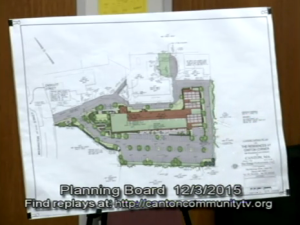Canton Center project in limbo over easement dispute
By Jay TurnerAfter a string of planning and zoning board hearings and numerous plan revisions, the owners of a proposed mixed-use/condo conversion project at the former Emerson and Cuming property on Washington Street are inching their way toward the finish line but still have a few sizable hurdles to clear.

Click image to view the 12/2 Planning Board hearing courtesy of CCTV. The discussion starts around the 56-minute mark.
Located a few lots north of Town Hall, the project promises a total transformation of the dilapidated factory site, with 8,000 square feet of retail/office space on the ground floor and a total of 58 condominiums on the upper floors, including 22 one-bedroom units and 36 two-bedroom units. The developer, JPM Development LLC, plans to preserve some of the historic features of the factory while also adding a clock tower and a “green” roof with vegetative cover.
The developer is seeking site plan approval and various forms of zoning relief under the Canton Center Economic Opportunity District (CCEOD), although the zoning on the site is complex to say the least, with two underlying districts (industrial and residential C) overlaid by CCEOD zones A and B, which both encourage mixed uses but have different density limits.
The two CCEOD zones also happen to have different requirements for open space, and after making considerable progress with the Planning Board on that front, the applicants had hoped to walk out of the most recent meeting on December 2 with a site plan approval in hand. However, they have since become entangled in a dispute with an abutting property owner that will push the deliberations at least past the new year.
At the heart of the dispute is an eight-foot drainage easement that the affected property owner, Michael Nemetz of Sherman Street, alleges does not exist. Nemetz’s attorney, Suzanne Matthews, told the Planning Board in late October and again last week that while her client does not want to derail the project, he does want an opportunity to negotiate with the developer before a decision is made.
“Today our position is that they don’t have the right to continue to drain on it,” Matthews said emphatically, while noting that the drainage has turned the property into wetlands. “Does Mr. Nemetz want to go out and get an injunction and try to stop that project? No, but we do need some time to try to see how we can resolve it.”
However, according to Paul Schneiders, attorney for the applicant, the easement in question, which is used to drain stormwater via an underground pipe, has been in use for more than 80 years and there are no plans by his client to alter it in any way.
Schneiders said the dispute amounts to a missing “piece of paper” and that under the legal definition of easement by prescription, after a “period of years that something has existed, you’re in no position to cry foul.”
Schneiders said that Nemetz had never raised a concern about the drainage over months of discussions and that his clients were actually prepared to give Nemetz a separate easement at no cost so that he could turn his “landlocked” piece of property into a buildable lot. But now, according to Schneiders, Nemetz is asking for an “exorbitant amount of money” for continued use of the drainage easement — an amount so substantial that it would “kill the project.”
At this point, Schneiders said he was “not at all optimistic” that the dispute would be resolved in the near future. “But I really hope the Planning Board doesn’t let this paper issue hold up what’s an excellent project for the town and what 100 percent of the abutters, including Mr. Nemetz, is in support of,” he said.
Schneiders suggested that the board move forward with the vote while making a resolution to the easement dispute a condition of approval.
At least one member, Jeremy Comeau, said he was comfortable with that approach and did not feel that the dispute was within the board’s purview. However, others, including George Jenkins, argued that a primary function of the Planning Board was to protect abutters and property owners, and the board ultimately agreed to continue the matter until January 6.
With regard to the addition of more open space, including the creation of a new public park at the front of the property and a “mini emerald necklace” that leads to the plaza level, board members were very much encouraged by the changes, although at least a few of them thought it fell a bit short of the stringent requirements of the CCEOD.
Board member Tori McClain expressed particular skepticism about the inclusion of the landscaped buffer around the perimeter of the property in the open space calculations, noting that the numbers seemed stretched. “I feel like we’re getting a straw man argument of what the real [amount of open space] is,” she said.
The applicants said they would take the board’s concerns under advisement and revisit the matter at their next meeting in January.
Short URL: https://www.thecantoncitizen.com/?p=31748










